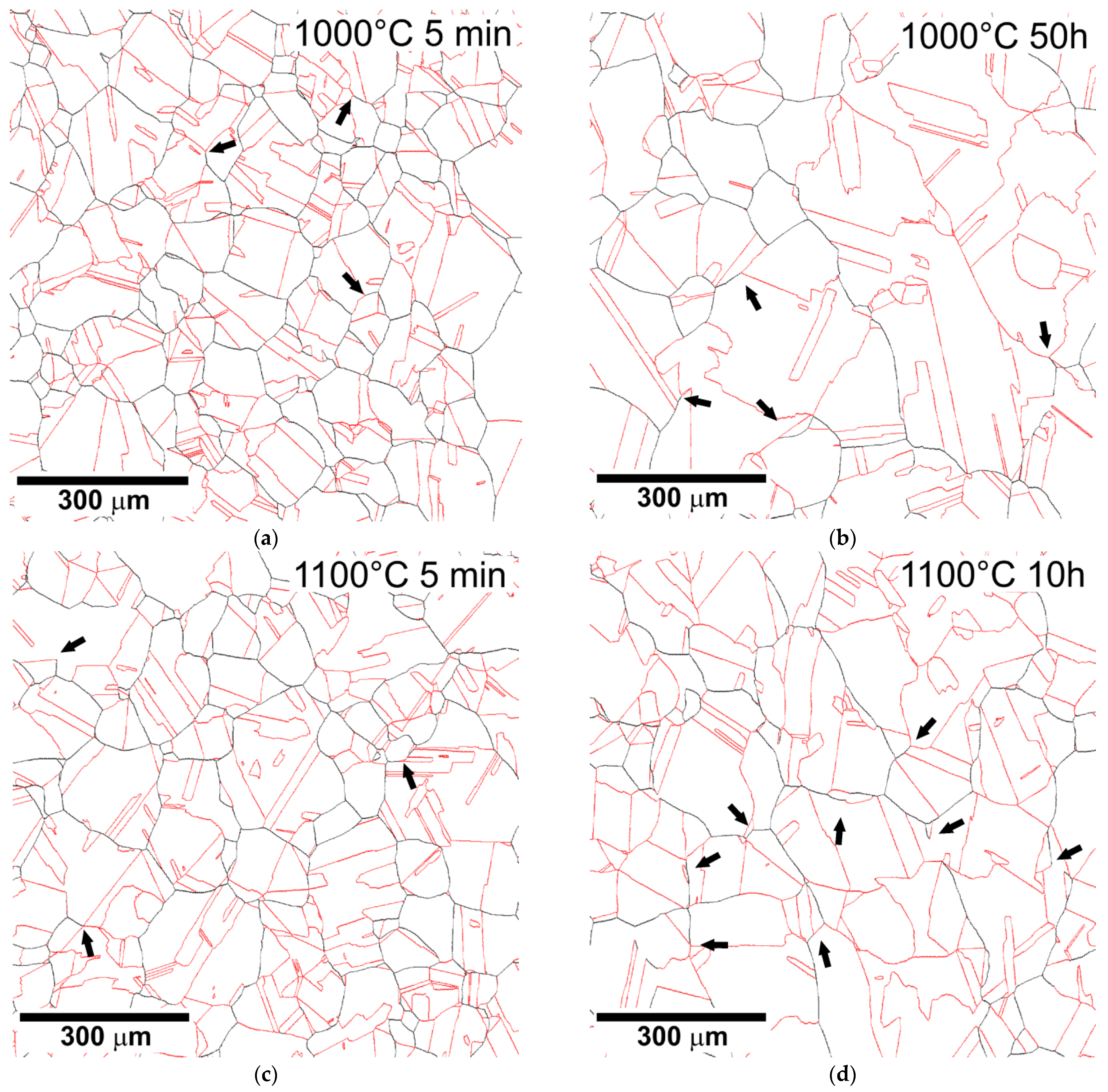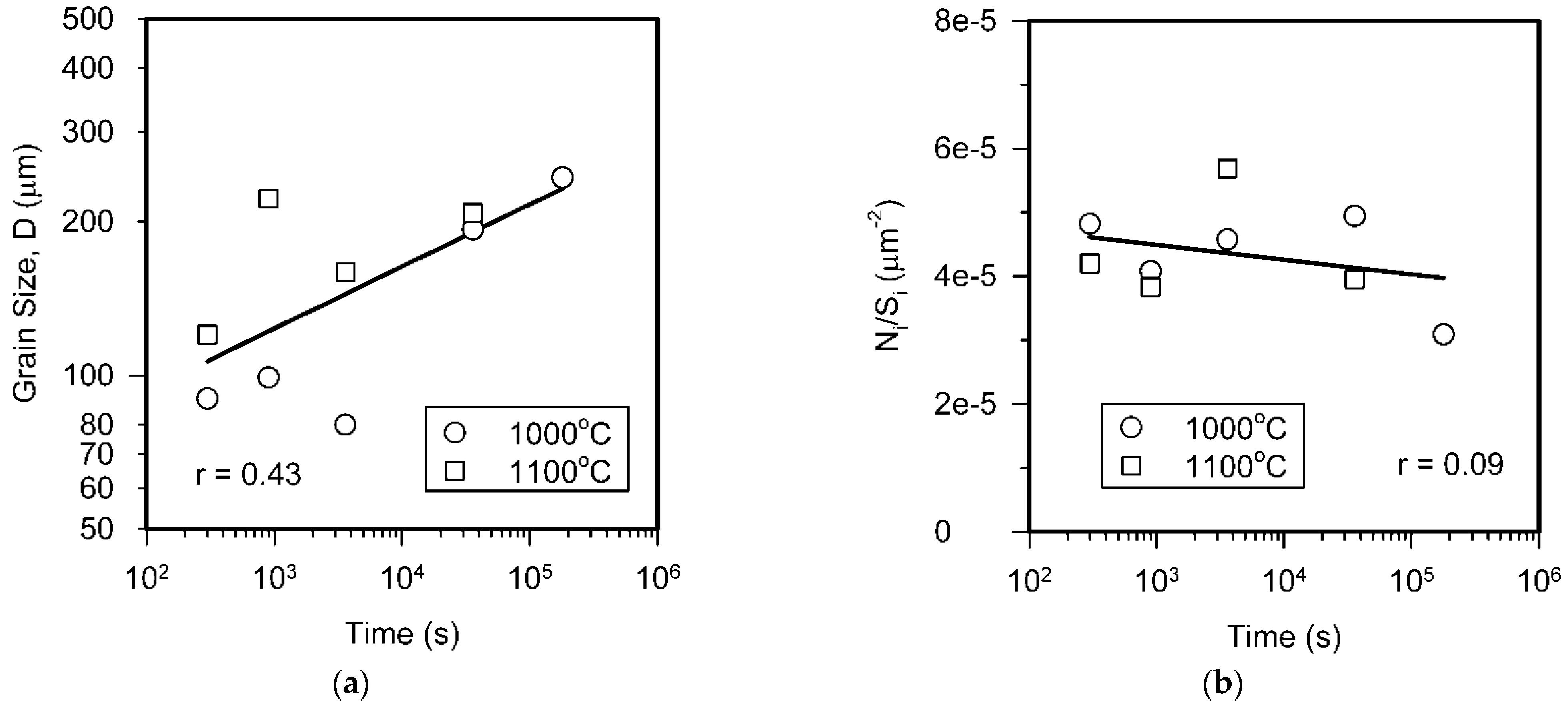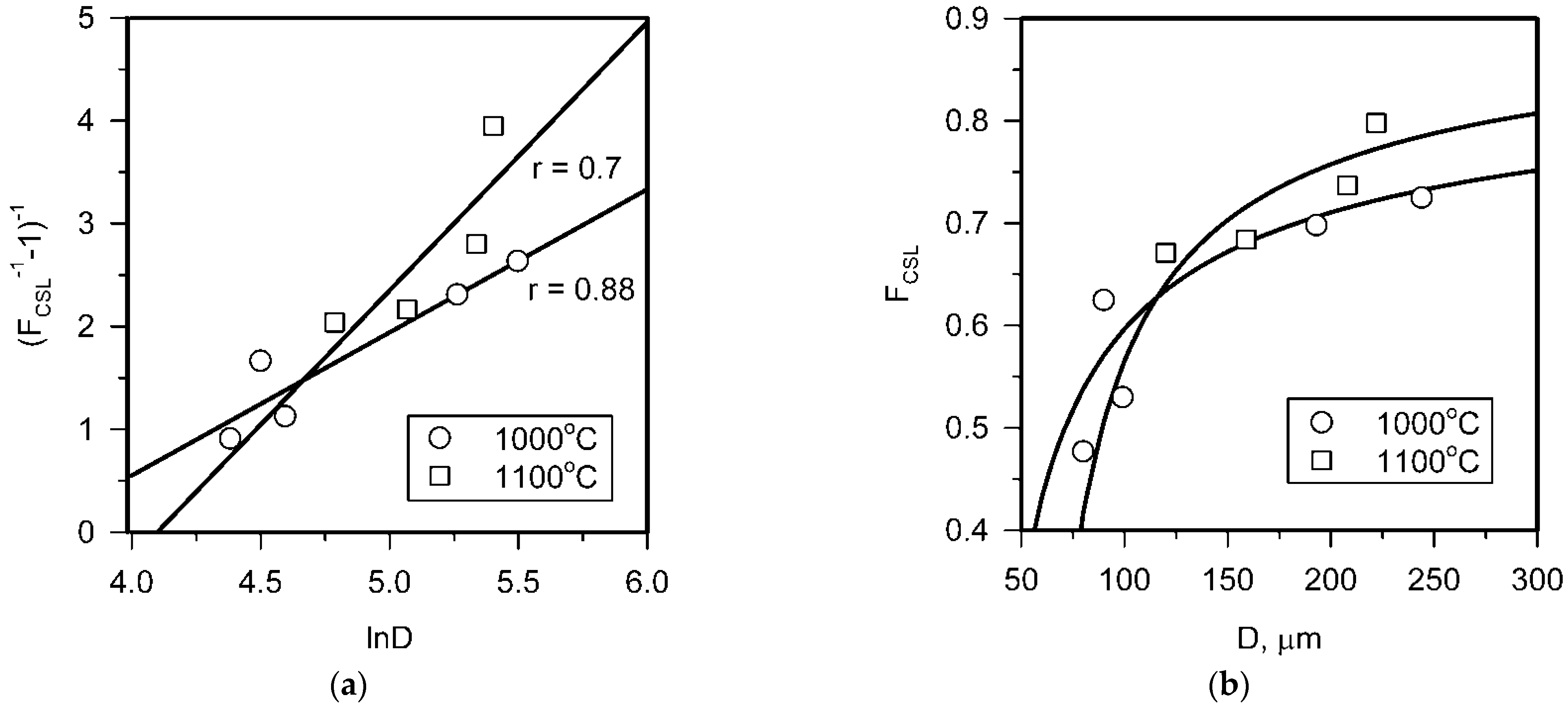On Grain Boundary Engineering for a 316L Austenitic Stainless Steel
Abstract
:1. Introduction
2. Materials and Methods
3. Results
3.1. Annealed Microstructures
3.2. Grain Boundary Interruption
4. Discussion
5. Conclusions
- The primary recrystallization readily developed during annealing at temperatures of T ≥ 1000 °C in the steel samples subjected to cold rolling with a reduction of 5%, resulting in the coarse-grained microstructures with a grain size of about 100 μm.
- The annealed microstructures were characterized by a large fraction of ∑3n CSL boundaries associated with numerous annealing twins. The fraction of these special boundaries increased with an increase in the grain size during prolonged annealing.
- The grain growth during annealing was accompanied by an increase in the number of grain boundary interruptions per grain. The relative number of the grain boundary interruptions can be expressed by a power law function of the grain size with an exponent of 2. Small strain cold rolling followed by prolonged recrystallization annealing is suggested as an advanced method of grain boundary engineering for austenitic stainless steels.
Author Contributions
Funding
Data Availability Statement
Acknowledgments
Conflicts of Interest
References
- Watanabe, T. Approach to Grain Boundary Design for Strong and Ductile Polycrystals. Res. Mech. 1984, 11, 47–84. [Google Scholar]
- Randle, V. The Measurement of Grain Boundary Geometry; Taylor and Francis Group: London, UK, 2017. [Google Scholar] [CrossRef]
- Gertsman, V.Y.; Bruemmer, S.M. Study of grain boundary character along intragranular stress corrosion crack paths in austenitic alloys. Acta Mater. 2001, 49, 1589–1598. [Google Scholar] [CrossRef]
- Watanabe, T.; Tsurekawa, S. Toughening of brittle materials by grain boundary engineering. Mater. Sci. Eng. A 2004, 387–389, 447–455. [Google Scholar] [CrossRef]
- Kobayashi, S.; Maruyama, T.; Tsurekawa, S.; Watanabe, T. Grain boundary engineering based on fractal analysis for control of segregation-induced intergranular brittle fracture in polycrystalline nickel. Acta Mater. 2012, 60, 6200–6212. [Google Scholar] [CrossRef]
- Palumbo, G.; Lehockey, E.M.; Lin, P. Applications for grain boundary engineered materials. J. Miner. 1998, 50, 40–43. [Google Scholar] [CrossRef]
- Gao, X.; Wang, M.; Liu, T.; Lu, Y.; Ejaz, A. Investigation on thermo-mechanical processing and intergranular corrosion of TP347H stainless steel. Mater. Sci. Technol. 2021, 37, 909–917. [Google Scholar] [CrossRef]
- Zhang, M.; Zhang, C.; Wu, H.; Yang, B. Effects of grain boundary engineering on the microstructure and corrosion fatigue properties of 316L austenitic stainless steel. Front. Mater. 2022, 9, 931848. [Google Scholar] [CrossRef]
- Watanabe, T. Grain boundary engineering: Historical perspective and future prospects. J. Mater. Sci. 2011, 46, 4095–4115. [Google Scholar] [CrossRef]
- Tsurekawa, S.; Nakamichi, S.; Watanabe, T. Correlation of grain boundary connectivity with grain boundary character distribution in austenitic stainless steel. Acta Mater. 2006, 54, 3617–3626. [Google Scholar] [CrossRef]
- Shimada, M.; Kokawa, H.; Wang, Z.J.; Sato, Y.S.; Karibe, I. Optimization of grain boundary character distribution for intergranular corrosion resistant 304 stainless steel by twininduced grain boundary engineering. Acta Mater. 2002, 50, 2331–2341. [Google Scholar] [CrossRef]
- Fang, X.; Wang, W.; Cai, Z.; Qin, C.; Zhou, B. The evolution of cluster of grains with Σ3n relationship in austenitic stainless steel. Mater. Sci. Eng. A 2010, A527, 1571–1576. [Google Scholar] [CrossRef]
- Pande, C.S.; Imam, M.A.; Rath, B.B. Study of Annealing Twins in FCC Metals and Alloys. Metall. Trans. A 1990, 21, 2891–2896. [Google Scholar] [CrossRef]
- Mahajan, S. Critique of mechanisms of formation of deformation, annealing and growth twins: Face-centered cubic metals and alloys. Scr. Mater. 2013, 68, 95–99. [Google Scholar] [CrossRef]
- Zhang, Y.-Q.; Quan, G.-Z.; Zhao, J.; Xiong, W. Influencing mechanisms of prio cold deformation on mixed grain boundary network in the thermal deformation of Ni80A superalloy. Materials 2022, 15, 6426. [Google Scholar] [CrossRef] [PubMed]
- Tikhonova, M.; Kuzminova, Y.; Fang, X.; Wang, W.; Kaibyshev, R.; Belyakov, A. Σ3 CSL boundary distributions in an austenitic stainless steel subjected to multidirectional forging followed by annealing. Philos. Mag. 2014, 94, 4181–4196. [Google Scholar] [CrossRef] [Green Version]
- Odnobokova, M.; Tikhonova, M.; Belyakov, A.; Kaibyshev, R. Development of Σ3n CSL boundaries in austenitic stainless steels subjected to large strain deformation and annealing. J. Mater. Sci. 2017, 52, 4210–4223. [Google Scholar] [CrossRef]
- Pande, C.S.; Imam, M.A. Grain growth and twin formation in boron-doped nickel polycrystals. Mater. Sci. Eng. A 2009, A512, 82–86. [Google Scholar] [CrossRef]
- Jin, Y.; Lin, B.; Bernacki, M.; Rohrer, G.S.; Rollet, A.D.; Bozzolo, N. Thermo-mechanical factors influencing annealing twin development in nickel during recrystallization. Mater. Sci. Eng. A 2014, A597, 295–303. [Google Scholar] [CrossRef] [Green Version]
- Fang, X.; Liu, Z.; Tikhonova, M.; Belyakov, A.; Wang, W. Evolution of texture and development of Σ3n grain clusters in 316 austenitic stainless steel during thermal mechanical processing. J. Mater. Sci. 2013, 48, 997–1004. [Google Scholar] [CrossRef]
- Humphreys, F.J.; Hatherly, M. Recrystallization and Related Annealing Phenomena; Elsevier Science: New York, NY, USA, 2004. [Google Scholar]
- Frost, H.J.; Ashby, M.F. Deformation Mechanism Maps; Pergamon Press: Oxford, UK, 1982. [Google Scholar]
- Sakai, T. Dynamic recrystallization microstructures under hot working conditions. J. Mater. Proc. Technol. 1995, 53, 349–361. [Google Scholar] [CrossRef]
- Chen, Z.; Chen, Y. Nanocrystalline gradient engineering: Grain evolution and grain boundary networks. Comp. Mater. Sci. 2018, 141, 282–292. [Google Scholar] [CrossRef]
- Czubayko, U.; Sursaeva, V.G.; Gottstein, G.; Shvindlerman, L.S. Influence of triple junctions on grain boundary motion. Acta Mater. 1998, 46, 5863–5871. [Google Scholar] [CrossRef]








Publisher’s Note: MDPI stays neutral with regard to jurisdictional claims in published maps and institutional affiliations. |
© 2022 by the authors. Licensee MDPI, Basel, Switzerland. This article is an open access article distributed under the terms and conditions of the Creative Commons Attribution (CC BY) license (https://creativecommons.org/licenses/by/4.0/).
Share and Cite
Dolzhenko, P.; Tikhonova, M.; Odnobokova, M.; Kaibyshev, R.; Belyakov, A. On Grain Boundary Engineering for a 316L Austenitic Stainless Steel. Metals 2022, 12, 2185. https://doi.org/10.3390/met12122185
Dolzhenko P, Tikhonova M, Odnobokova M, Kaibyshev R, Belyakov A. On Grain Boundary Engineering for a 316L Austenitic Stainless Steel. Metals. 2022; 12(12):2185. https://doi.org/10.3390/met12122185
Chicago/Turabian StyleDolzhenko, Pavel, Marina Tikhonova, Marina Odnobokova, Rustam Kaibyshev, and Andrey Belyakov. 2022. "On Grain Boundary Engineering for a 316L Austenitic Stainless Steel" Metals 12, no. 12: 2185. https://doi.org/10.3390/met12122185
APA StyleDolzhenko, P., Tikhonova, M., Odnobokova, M., Kaibyshev, R., & Belyakov, A. (2022). On Grain Boundary Engineering for a 316L Austenitic Stainless Steel. Metals, 12(12), 2185. https://doi.org/10.3390/met12122185







